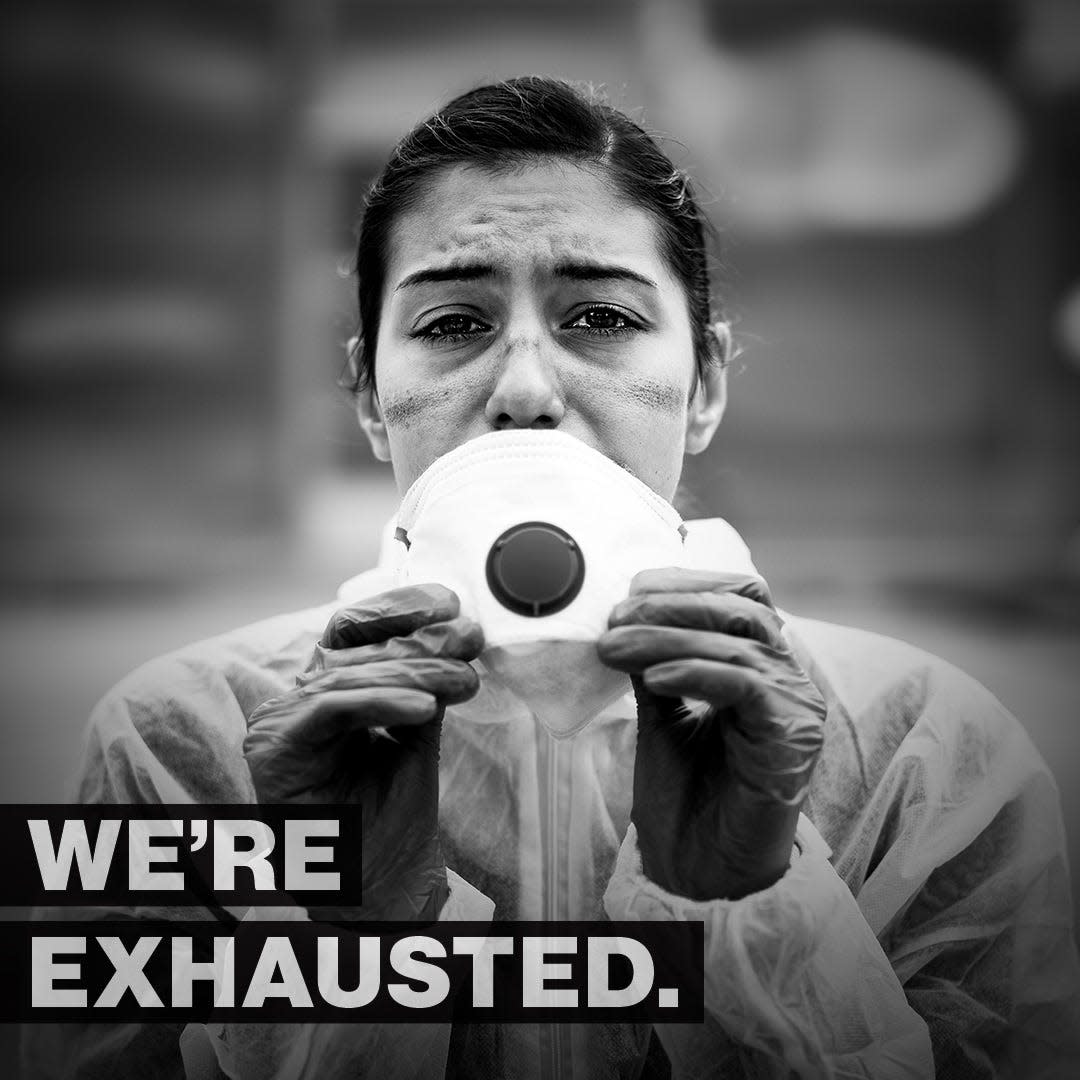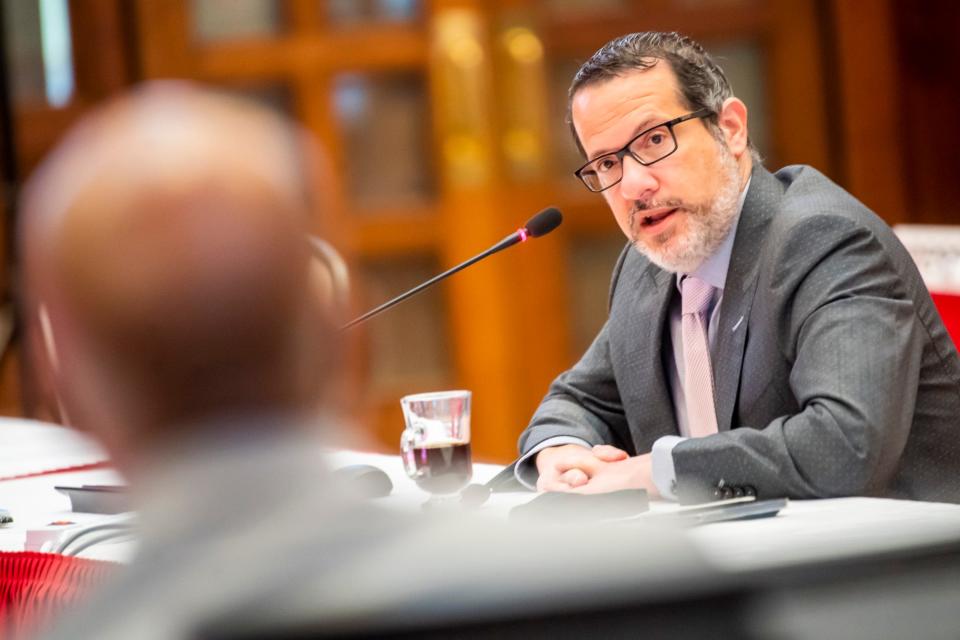IU Health: 'Hundreds of patients' cannot get surgeries as COVID-19 surges

Local health and government officials are sounding the alarm: Spiking COVID-19 cases, primarily of unvaccinated people, are threatening to overwhelm exhausted hospital workers.
“Our hospitals are at our highest capacity we’ve seen,” said Brian Shockney, president of Indiana University Health's South Central Region.
Shockney also said the hospital system increasingly has to move additional staff to the bedsides of COVID patients and away from their normal responsibilities, which include surgeries.
That means many patients who have been waiting for surgeries will have to continue to wait.
'Stretched beyond prior belief': Hospitals strive to handle latest COVID-19 surge
“We have hundreds of patients who need surgery, who are in pain, who have conditions that require surgery, and we cannot do them,” Shockney said.
Some patients have had to reschedule their surgeries for the third time since the pandemic began, he said, which, beyond potential medical complications, also is raising their out-of-pocket costs as the start of a new year means the patients have to meet their deductible anew.

And a record of more than 100 IU Health employees have been temporarily sidelined because of COVID-19 symptoms or quarantines, worsening an already existing staffing shortage. To make matters worse, 12 National Guard members who had been supporting this region's IU Health system, including the hospital in Bloomington, left on Wednesday for other assignments.
“They were critically important,” Shockney said at a Friday coronavirus update given by local city, county and health agency officials.
The Guard members helped stock shelves and sat with patients. Shockney said those duties would now be fulfilled by him and other administrative staff.
He said it will take the health system months to overcome that surgery backlog once the coronavirus surge ends.
Bloomington health care workers: 'People are acting like COVID is over ... it's not'
Shockney on Friday also reiterated a recent media campaign through which the health system is asking Hoosiers for help.
“Our teams are tired,” one poster read. “We can’t do this alone,” read another.
While Shockney said that people who need urgent help will not be turned away from the hospital, the surging number of patients, coupled with the staffing constraints, is forcing the system to change the way it takes care of patients. For example, the system has moved to a “team nursing” model, where a team of nurses oversees a pod of patients, rather than patients receiving the one-on-one nursing care they would get outside of the pandemic.
Shockney also said that it’s too soon to tell what share of people infected with the omicron variant need to be hospitalized. While data from other nations, such as South Africa and the United Kingdom, suggest that a lower share of people infected with the omicron variant have to be hospitalized — compared with those infected with the delta variant — Shockney warned that vaccination rates and demographics in those other countries make comparisons with the United States difficult.
In addition, he said, even if a smaller share of omicron infections require hospitalization, the sheer number of omicron cases could still overwhelm hospitals.
Simple math bears this out: If omicron cases cause half as many hospitalizations as delta cases, hospitals still have to deal with a larger number of patients if omicron causes more than twice as many cases as delta.
“Our hospitalizations are not declining,” Shockney said.
Health care workers: Compassion fatigue, exhaustion and frustration
The state recorded 15,264 COVID-19 cases Wednesday, about three times as many as the record high during the delta surge over the summer and more than twice as many as the record high during the surge in late 2020.
The disease continues to claim lives. On the state's COVID-19 dashboard Friday, deaths of Monroe County residents with confirmed active cases of COVID-19 over the course of the pandemic rose to 236. That's up from 220 deaths on Dec. 3 and 200 on Oct. 22.
Infections also have risen among government employees, with the city of Bloomington reporting Thursday that 14 city workers had tested positive in the first six days of the year. That included one employee at the police department and three at the fire department. The prior week, five police officers had tested positive, but a department spokesman said the infections did not have a big impact because “many” of those officers were already scheduled to be off over the holidays.
However, the infections have forced the city to close the Banneker Community Center through Jan. 17.
Health, city and university officials said they worry the situation will get worse before it gets better because the more contagious omicron variant likely has yet to fully engulf the state. They urged people to get vaccinated, get booster shots, get tested if they feel sick, to wear masks when indoors and to remain at least 6 feet apart from others.
“Just don’t share air if you don’t have to,” said Mayor John Hamilton.
Where can I get tested?
The rising number of cases also is making it difficult to get testing appointments and very difficult to find at-home tests.
Penny Caudill, administrator of the Monroe County Health Department, urged people who have symptoms to find a testing site and make an appointment through the Indiana State Department of Health website: tinyurl.com/2p8d8vjt.
The high number of tests also is overwhelming the laboratories that analyze the tests, which may prolong the turnaround times, Caudill said. People may have gotten used to getting their results within 24 hours, but they now may have to wait 48 or even 72 hours.
People who are symptomatic and do not have access to a test right away should assume that they have COVID-19 and should isolate to prevent infecting others.
“Please don’t spread it to other people,” Caudill said.
What mask should I wear?
Caudill said people should avoid infections with omicron the same way that they have protected themselves from the other variants. That means good hand washing, staying at least 6 feet apart, getting vaccinated, getting a booster shot when appropriate and wearing masks.
Any mask is better than none, Caudill said, but a quality mask — multiple layers, tight fit, N95 or KN95 — can reduce infection risk even more. She also warned though, that masks must fit tightly, and that a poorly fitting KN95 mask may offer less protection than a well-fitting cloth mask.
People need to make sure, for example, that the mask covers the mouth and — not or — the nose.
Myth: Vaccines don’t work
IU Health South Central Region data on Friday showed that of 50 people who were hospitalized with COVID-19 at its Bloomington, Bedford and Paoli hospitals, 36, or 72%, were unvaccinated. Of 14 patients in the ICU, 11, or 79%, were unvaccinated. Of the 10 patients on ventilators, seven, or 70%, were unvaccinated.

While the share of patients who are getting infected despite vaccinations has increased slightly, IU’s Chief Medical Officer Dr. Aaron Carroll said the metric is misleading, because as more people get vaccinated, more people with vaccinations will get breakthrough cases. In other words, if everyone were vaccinated, 100% of cases would be occurring in people with vaccinations.
“It’s important to remember that the purpose of vaccines was first and foremost not to prevent cases. It was to prevent bad outcomes from cases, like hospitalizations and death. And they have worked spectacularly so far through every single variant in providing that benefit,” Carroll said.
“Every week ,,, we talk about how the hospitals are ... stressed almost entirely with unvaccinated people,” he said. “Yes, some breakthrough cases do occur, but being vaccinated massively protects you against those bad outcomes.
“If we shift this illness through vaccination to one where people get it but nobody gets very ill, that’s a massive win,” Carroll said.
Where to get vaccinated: coronavirus.in.gov/vaccine/
Boris Ladwig is the city government reporter for The Herald-Times. Contact him at bladwig@heraldt.com.
This article originally appeared on The Herald-Times: IU Health: 'Hundreds of patients' cannot get surgeries as COVID surges

